PONTIAC FIREBIRD History
Introduction: Having
watched first the Ford Mustang and then the Chevrolet Camaro enter into
the pony car market, Pontiac finally got into the act in the middle of
1967. The Firebird was offered with both six and eight cylinder engines,
like the Mustang and Camaro, and was based heavily on the Chevrolet Camaro
chassis. Pontiac did try to make it their own and would create a European
styled and mannered pony car that could hold its own against its more experienced
competition.
1967 Pontiac Firebird
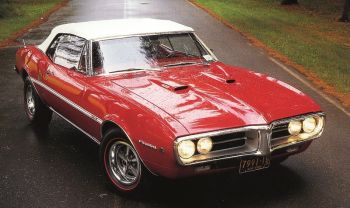 Comments:
The Pontiac Firebird was released five months after the Chevrolet Camaro,
and offered buyers choices of six and eight cylinder engines. Pontiac was
able to use that additional time to create a unique identity for the Firebird,
despite having to use the Camaro chassis. Initially, five different Firebirds
were available, named after their respective engine choices. The top engine
choice was the 400 V8 borrowed from the GTO. This engine was rated at 325
bhp, and was available with or without Ram Air (which suspiciously didn't
affect the engine rating, hmm.) The Ram Air engine included a hotter cam,
stronger valve springs, and made use of the otherwise decrorative hood
scoops. A heavy-duty three speed was standard, a four speed manual and
three speed automatic were optional. Performance axle ratios up to 4.33:1
were available as well as front disk brakes. Firebird prices were roughly
0 more than comprable Camaros and the Camaro outsold it two to one.
But Pontiac's pony car had arrived. Comments:
The Pontiac Firebird was released five months after the Chevrolet Camaro,
and offered buyers choices of six and eight cylinder engines. Pontiac was
able to use that additional time to create a unique identity for the Firebird,
despite having to use the Camaro chassis. Initially, five different Firebirds
were available, named after their respective engine choices. The top engine
choice was the 400 V8 borrowed from the GTO. This engine was rated at 325
bhp, and was available with or without Ram Air (which suspiciously didn't
affect the engine rating, hmm.) The Ram Air engine included a hotter cam,
stronger valve springs, and made use of the otherwise decrorative hood
scoops. A heavy-duty three speed was standard, a four speed manual and
three speed automatic were optional. Performance axle ratios up to 4.33:1
were available as well as front disk brakes. Firebird prices were roughly
0 more than comprable Camaros and the Camaro outsold it two to one.
But Pontiac's pony car had arrived.
Production: Hardtop
Coupe: 67,032 Convertible: 15,526
Engines: 230 I6 165
bhp. 230 I6 215 bhp. 326 V8 250 bhp. 326 V8 285 bhp. 400 V8 325 bhp @ 4800
rpm, 410 lb-ft @ 3400 rpm. 400 V8 (Ram Air) 325 bhp @ 5200 rpm, 410 lb-ft
@ 3400 rpm.
Performance: 400/325:
0-60 in 6.2 sec, 1/4 mile in 14.7 sec @ 98 mph.
1968 Pontiac Firebird
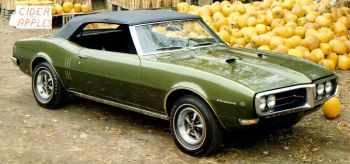 Comments:
The Pontiac Firebird underwent minor changes for its second year. On the
exterior, it lost its side vent windows and gained fender marker lights.
The interior was revised and the rear suspension was refined. The big news
was under the hood. The standard 400 engine gained 5 bhp to 330 while the
Ram Air engine was rated at 335 bhp. In mid year, it was replaced by the
340 bhp Ram Air II. Newly available was a third 400 V8, named the HO (High
Output) that was slotted between the two other engines. The 400 HO cam
with free-flow exhausts and its own revised cam (when mated to the four
speed manual). It too was rated at 335 bhp. On the lower side of the model
line, the 230 I6 was replaced by a new 250 I6 and the 326 V8s were replaced
by new 350 V8. Performance was definitely the key at Pontiac. Comments:
The Pontiac Firebird underwent minor changes for its second year. On the
exterior, it lost its side vent windows and gained fender marker lights.
The interior was revised and the rear suspension was refined. The big news
was under the hood. The standard 400 engine gained 5 bhp to 330 while the
Ram Air engine was rated at 335 bhp. In mid year, it was replaced by the
340 bhp Ram Air II. Newly available was a third 400 V8, named the HO (High
Output) that was slotted between the two other engines. The 400 HO cam
with free-flow exhausts and its own revised cam (when mated to the four
speed manual). It too was rated at 335 bhp. On the lower side of the model
line, the 230 I6 was replaced by a new 250 I6 and the 326 V8s were replaced
by new 350 V8. Performance was definitely the key at Pontiac.
Production: Hardtop
Coupe: 90,152 Convertible: 16,960
Engines: 250 I6 175
bhp. 250 I6 215 bhp. 250 I6 230 bhp. 350 V8 265 bhp. 350 V8 330 bhp. 400
V8 330 bhp @ 4800rpm, 430 lb-ft @ 3300 rpm. 400 V8 (HO) 335 bhp @ 5000
rpm, 430 lb-ft @ 3400 rpm. 400 V8 (Ram Air) 335 bhp @ 5300 rpm, 430 lb-ft
@ 3600 rpm.
Performance: 400/335
(HO): 0-60 in 5.5 sec, 1/4 mile in 14.2 sec @ 100 mph.
1969 Pontiac Firebird
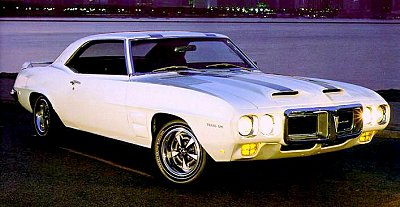 Comments:
The Pontiac Firebird underwent a major restyling for the 1969 model year.
The front end was redone and the rear end and interior were changed slightly.
The redesign did not do well with customers, and sales fell, despite the
fact that production lasted for 17 months, well into 1970 due to production
problems with the 1970 model. The Ram Air 400 was renamed the Ram Air IV
and had a slight increase in power. The 400 HO option was known as either
the Ram Air, Ram Air II, or simply HO. It too received a slight increase
in power. In March of 1969, Pontiac released a little publicized option
package, the Trans Am Performance and Appearance Package. Offered as a
5 option, only 689 Firebird coupes and 8 convertibles (talk about a
collectible) were built. Although not appearent at the time, the Pontiac
Firebird Trans Am, along with the Chevrolet Corvette, would be the only
American high performance cars that would remain in continuous production
since their inception. The Trans Am came standard with the HO engine with
Ram Air (also called the Ram Air III). The only engine option was the 400
Ram Air IV, ordered on just 55 coupes and all 8 convertibles. All Trans
Ams were Polar White with blue racing stripes, tail panel, and decals.
The exclusive hood had functional air intakes which could be closed by
the driver and functional fender scoops designed to vent the engine bay.
A 60 inch rear foil (spoiler) was mounted on the trunk. Although the Trans
Am was no faster than similarly equiped Firebirds, it represented the peak
of Pontiac performance excitement. Comments:
The Pontiac Firebird underwent a major restyling for the 1969 model year.
The front end was redone and the rear end and interior were changed slightly.
The redesign did not do well with customers, and sales fell, despite the
fact that production lasted for 17 months, well into 1970 due to production
problems with the 1970 model. The Ram Air 400 was renamed the Ram Air IV
and had a slight increase in power. The 400 HO option was known as either
the Ram Air, Ram Air II, or simply HO. It too received a slight increase
in power. In March of 1969, Pontiac released a little publicized option
package, the Trans Am Performance and Appearance Package. Offered as a
5 option, only 689 Firebird coupes and 8 convertibles (talk about a
collectible) were built. Although not appearent at the time, the Pontiac
Firebird Trans Am, along with the Chevrolet Corvette, would be the only
American high performance cars that would remain in continuous production
since their inception. The Trans Am came standard with the HO engine with
Ram Air (also called the Ram Air III). The only engine option was the 400
Ram Air IV, ordered on just 55 coupes and all 8 convertibles. All Trans
Ams were Polar White with blue racing stripes, tail panel, and decals.
The exclusive hood had functional air intakes which could be closed by
the driver and functional fender scoops designed to vent the engine bay.
A 60 inch rear foil (spoiler) was mounted on the trunk. Although the Trans
Am was no faster than similarly equiped Firebirds, it represented the peak
of Pontiac performance excitement.
Production: Hardtop
Coupe: 76,059 Convertible: 11,649 Trans Am Hardtop Coupe: 689 Trans Am
Convertible: 8
Engines: 250 I6 175
bhp. 250 I6 215 bhp. 250 I6 230 bhp. 350 V8 265 bhp. 350 V8 330 bhp. 400
V8 330 bhp @ 4800rpm, 430 lb-ft @ 3300 rpm. 400 V8 (HO) 335 bhp @ 5000rpm,
430 lb-ft @ 3400 rpm. 400 V8 (Ram Air II) 335 bhp @ 5000 rpm, 430 lb-ft
@ 3400 rpm. 400 V8 (Ram Air IV) 345 bhp @ 5400 rpm, 430 lb-ft @ 3700 rpm.
Performance: 400/335
(RA IV): 0-60 in 6.3 sec, 1/4 mile in 14.1 sec @ 101 mph.
1970 Pontiac Firebird
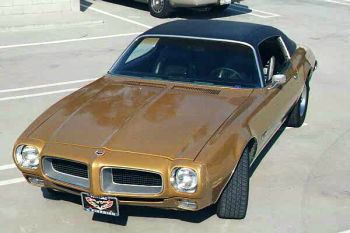 Comments:
An all new Pontiac Firebird was introduced for 1970 and represented a new
high for Pontiac styling. The front bumper and grille were molded out of
Endura rubber and were painted the same color as the car. The sides sported
full wheel cut outs without any extra trim. The suspension was revised
and a rear stabilizer bar was added. Sadly, the convertible was eliminated.
The Firebird lineup was reduced from six to four and once again the Trans
Am was the top choice. The Trans Am was fitted with air dams across the
bottom of the front and in front of the wheels. A large decklip lip and
small spoilers in front of the rear wheels completed the package. These
aero pieces were claimed to generate 50 pounds of downforce on the front
and rear of the car at highway speeds. Trans Ams also received a rear facing
shaker hood scope to feed the standard Ram Air II engine. Optional on the
Trans Am was the Ram Air IV engine, whose output had increased to 370 bhp
due to bigger ports, better heads, swirl-polished valves, and an aluminum
instake manifold. Only 88 copies were made. Rarer still was the Ram Air
V, an over-the-counter, special order engine that included solid lifters
and tunnel port heads and made up to 500 bhp. Inside, complete instrumentation,
including a tach turned on its side to red line at 12 o'clock just like
a race car, completed the performance image. The Trans Am was now available
in either blue or white, with contrasting stripes. A four speed Hurst shifter
was standard, but a three speed Turbo Hydra-matic automatic was available. Comments:
An all new Pontiac Firebird was introduced for 1970 and represented a new
high for Pontiac styling. The front bumper and grille were molded out of
Endura rubber and were painted the same color as the car. The sides sported
full wheel cut outs without any extra trim. The suspension was revised
and a rear stabilizer bar was added. Sadly, the convertible was eliminated.
The Firebird lineup was reduced from six to four and once again the Trans
Am was the top choice. The Trans Am was fitted with air dams across the
bottom of the front and in front of the wheels. A large decklip lip and
small spoilers in front of the rear wheels completed the package. These
aero pieces were claimed to generate 50 pounds of downforce on the front
and rear of the car at highway speeds. Trans Ams also received a rear facing
shaker hood scope to feed the standard Ram Air II engine. Optional on the
Trans Am was the Ram Air IV engine, whose output had increased to 370 bhp
due to bigger ports, better heads, swirl-polished valves, and an aluminum
instake manifold. Only 88 copies were made. Rarer still was the Ram Air
V, an over-the-counter, special order engine that included solid lifters
and tunnel port heads and made up to 500 bhp. Inside, complete instrumentation,
including a tach turned on its side to red line at 12 o'clock just like
a race car, completed the performance image. The Trans Am was now available
in either blue or white, with contrasting stripes. A four speed Hurst shifter
was standard, but a three speed Turbo Hydra-matic automatic was available.
Production: Formula
400: 7,708 Trans Am: 3,196
Engines: 250 I6 155
bhp. 350 V8 255 bhp. 400 V8 265 bhp. 400 V8 330 bhp @ 4800rpm, 430 lb-ft
@ 3000 rpm. 400 V8 (HO) 335 bhp @ 5000rpm, 430 lb-ft @ 3400 rpm. 400 V8
(Ram Air II) 345 bhp @ 5000 rpm, 430 lb-ft @ 3400 rpm. 400 V8 (Ram Air
IV) 370 bhp @ 5500 rpm, 445 lb-ft @ 3900 rpm. 400 V8 (Ram Air V) 500bhp.
Performance: 400/370
(RA IV): 0-60 in 5.6 sec, 1/4 mile in 13.9 sec @ 102 mph.
1971 Pontiac Firebird
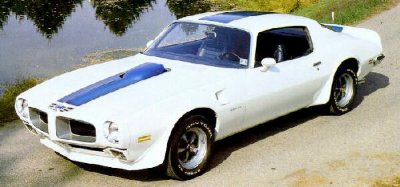 Comments:
1971 saw little styling change for the Pontiac Firebird. Rather, the major
changes were under the hood. In order to satisfy General Motors decree
that all engines had to run on unleaded gasoline to meet federal emission
standards, the engine options were significantly alter. A new 400 V8 w/
300 bhp was added, but both 400 Ram Air engines were dropped. In their
place were two new 455 V8s, rated at 325 bhp and 335 bhp. The 455 HO engine
was only available in the Trans Am and borrowed the cylinder heads from
the 1970 Ram Air II and the intake manifold from the 1970 Ram Air IV. The
Trans Am continued with its blue and white paint scheme, functional rear
facing engine shaker hood scoops, and aero body pieces. Although the 455's
available in the Trans Am were less powerful than the 1970 Ram Air II and
IV engines, its 480 lb-ft of torque and less tempermental nature made it
easier to drive on the street and was one of the high points in a time
when performance was on the decline. Comments:
1971 saw little styling change for the Pontiac Firebird. Rather, the major
changes were under the hood. In order to satisfy General Motors decree
that all engines had to run on unleaded gasoline to meet federal emission
standards, the engine options were significantly alter. A new 400 V8 w/
300 bhp was added, but both 400 Ram Air engines were dropped. In their
place were two new 455 V8s, rated at 325 bhp and 335 bhp. The 455 HO engine
was only available in the Trans Am and borrowed the cylinder heads from
the 1970 Ram Air II and the intake manifold from the 1970 Ram Air IV. The
Trans Am continued with its blue and white paint scheme, functional rear
facing engine shaker hood scoops, and aero body pieces. Although the 455's
available in the Trans Am were less powerful than the 1970 Ram Air II and
IV engines, its 480 lb-ft of torque and less tempermental nature made it
easier to drive on the street and was one of the high points in a time
when performance was on the decline.
Production: Formula:
7,802 Trans Am: 2,116
Engines: 400 V8 300
bhp @ 4800rpm, 400 lb-ft @ 3600 rpm. 455 V8 325 bhp @ 4400 rpm, 455 lb-ft
@ 3200 rpm. 455 V8 (HO) 335 bhp @ 4800 rpm, 480 lb-ft @ 3600 rpm.
Performance: 455/335
(HO): 0-60 in 5.9 sec, 1/4 mile in 13.9 sec @ 103 mph.
1972 Pontiac Firebird
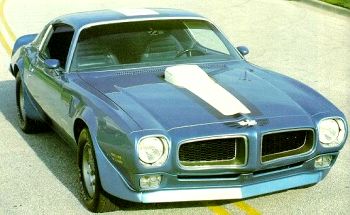 Comments:
1972 was a disasterous year for the Firebird. GM executives considered
dropping the Firebird altogether as sales fell drastically as the muscle
car market collapsed, which was worsened by a crippling 174 day strike
at the only plant that produced Firebirds. Pontiac executives were able
to eventually save the Firebird and it continued, with very little change
from 1971 except that its engines were now rated in net SAE numbers. Comments:
1972 was a disasterous year for the Firebird. GM executives considered
dropping the Firebird altogether as sales fell drastically as the muscle
car market collapsed, which was worsened by a crippling 174 day strike
at the only plant that produced Firebirds. Pontiac executives were able
to eventually save the Firebird and it continued, with very little change
from 1971 except that its engines were now rated in net SAE numbers.
Production: Formula:
5,249 Trans Am: 1,286
Engines: 400 V8 250
bhp @ 4400rpm, 325 lb-ft @ 3200 rpm. 455 V8 300 bhp @ 4000 rpm, 415 lb-ft
@ 3200 rpm.
1973 Pontiac Firebird
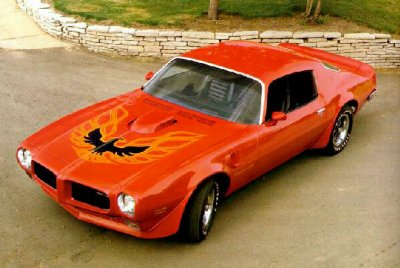 Comments:
1973 saw some significant new changes to the Firebird, and the revision
of the front bumper. A new Super Duty (SD) 455 V8 was made available, which
re-established Pontiac as the performance manufacturer during the dark
days of the 1970s. The Super Duty engine (the name was used on high performance
Pontiac engines in the early 1960s) were all hand assembled and put out
an impressive 310 bhp and 390 lb-ft, in an era when other manufacturer's
engines' output were falling dramatically. Also available on the Trans
Am was a new Firebird decal, which was quickly named "the screaming chicken"
which added to the excitement and popularity of the entire Firebird lineup.
Sales of the Firebird and Trans Am were up dramatically, ensuring their
survival until the present day. Comments:
1973 saw some significant new changes to the Firebird, and the revision
of the front bumper. A new Super Duty (SD) 455 V8 was made available, which
re-established Pontiac as the performance manufacturer during the dark
days of the 1970s. The Super Duty engine (the name was used on high performance
Pontiac engines in the early 1960s) were all hand assembled and put out
an impressive 310 bhp and 390 lb-ft, in an era when other manufacturer's
engines' output were falling dramatically. Also available on the Trans
Am was a new Firebird decal, which was quickly named "the screaming chicken"
which added to the excitement and popularity of the entire Firebird lineup.
Sales of the Firebird and Trans Am were up dramatically, ensuring their
survival until the present day.
Production: Formula:
10,166 Trans Am: 4,802
Engines: 400 V8 230
bhp @ 4400rpm, 325 lb-ft @ 3200 rpm. 455 V8 250 bhp @ 4000 rpm, 370 lb-ft
@ 2800 rpm. 455 (SD) V8 310 bhp @ 4000 rpm, 390 lb-ft @ 3600 rpm.
1974 Pontiac Firebird
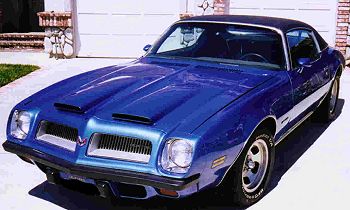 Comments:
1974 was a difficult year for the Firebird. Gone was the Endura bumper,
replaced by new, Federally mandated, fiberglass front end and rubber covered
5 mph bumpers. The chrome rear bumper was also gone, replaced by those
pesky rubber bumpers. The base engine on Trans Am's was the 225 bhp 400
V8. But for a mere , buyers could order the 250 bhp 455 V8, which received
a 10 lb-ft boost to 380 lb-ft, but came only with an automatic transmission.
The mighty Super Duty 455 V8 was also available for an additional 8
and were unchanged from the year before. All V8s included true dual exhausts,
which made their last appearance on the Firebird. Also available for the
last time on the 1974 Firebirds were the Muncie 4-speed manual transmission
and the TurboHydramatic 400 automatic transmission. The lower output of
the 1975 engines would make those heavyduty transmissions unnecessary. Comments:
1974 was a difficult year for the Firebird. Gone was the Endura bumper,
replaced by new, Federally mandated, fiberglass front end and rubber covered
5 mph bumpers. The chrome rear bumper was also gone, replaced by those
pesky rubber bumpers. The base engine on Trans Am's was the 225 bhp 400
V8. But for a mere , buyers could order the 250 bhp 455 V8, which received
a 10 lb-ft boost to 380 lb-ft, but came only with an automatic transmission.
The mighty Super Duty 455 V8 was also available for an additional 8
and were unchanged from the year before. All V8s included true dual exhausts,
which made their last appearance on the Firebird. Also available for the
last time on the 1974 Firebirds were the Muncie 4-speed manual transmission
and the TurboHydramatic 400 automatic transmission. The lower output of
the 1975 engines would make those heavyduty transmissions unnecessary.
Production: Formula:
Trans Am: 10,255 Super Duty 455: 943
Engines: 400 V8 225
bhp @ 4000 rpm, 330 lb-ft @ 2800 rpm. 455 V8 250 bhp @ 4000 rpm, 380 lb-ft
@ 2800 rpm. 455 (SD) V8 310 bhp @ 4000 rpm, 390 lb-ft @ 3600 rpm.
Performance: SD455/310:
1/4 mile in 13.5 seconds @ 104 mph
1975 Pontiac Firebird
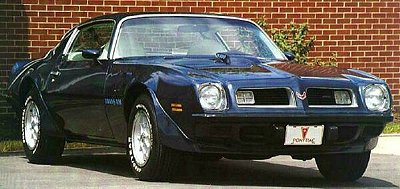 Comments:
In what had been a sea of pony car competitors, the Pontiac Firebird was
all alone for 1975. The Camaro Z28, AMC Javelin, Plymouth Barracuda, and
Dodge Challenger all were discontinued. The Ford Mustang was now offered
on a Pinto platform and boasted a top engine offering of a 105 bhp 2.8
liter V6! The 1975 Firebird featured a new front end (it's third in three
years) and a much improved rear window, which greatly improved visibility.
The instrument panel stayed the same, but the old 160 mph speedometer was
replaced by a new 100 mph unit, to reflect the new times. The base 400
cid V8 Trans Am engine put out a pitiful 185 bhp, but still cranked out
310 lb-ft of torque. But the big news was what was lost: No Super Duty
455 engine, no Turbo-Hydramatic 400 automatic transmission, no Muncie Four-Speed
Manual Transmission, no true dual exhausts. The main culprit: the new Federally
mandated Catalytic Converters. The 455 V8 continued in "H.O." guise, but
it was just the 455 engine from the Bonneville and produced only 200 bhp. Comments:
In what had been a sea of pony car competitors, the Pontiac Firebird was
all alone for 1975. The Camaro Z28, AMC Javelin, Plymouth Barracuda, and
Dodge Challenger all were discontinued. The Ford Mustang was now offered
on a Pinto platform and boasted a top engine offering of a 105 bhp 2.8
liter V6! The 1975 Firebird featured a new front end (it's third in three
years) and a much improved rear window, which greatly improved visibility.
The instrument panel stayed the same, but the old 160 mph speedometer was
replaced by a new 100 mph unit, to reflect the new times. The base 400
cid V8 Trans Am engine put out a pitiful 185 bhp, but still cranked out
310 lb-ft of torque. But the big news was what was lost: No Super Duty
455 engine, no Turbo-Hydramatic 400 automatic transmission, no Muncie Four-Speed
Manual Transmission, no true dual exhausts. The main culprit: the new Federally
mandated Catalytic Converters. The 455 V8 continued in "H.O." guise, but
it was just the 455 engine from the Bonneville and produced only 200 bhp.
Production: Formula:
Trans Am: 27,274
Engines: 400 V8 185
bhp, 310 lb-ft. 455 V8 200 bhp @ 3800 rpm, 330 lb-ft @ 2000 rpm. 455 (SD)
V8 310 bhp @ 4000 rpm, 390 lb-ft @ 3600 rpm.
Performance: 455/200:
1/4 mile in 16.1 seconds @ 89 mph
History from: www.musclecarclub.com
Tagasi
|